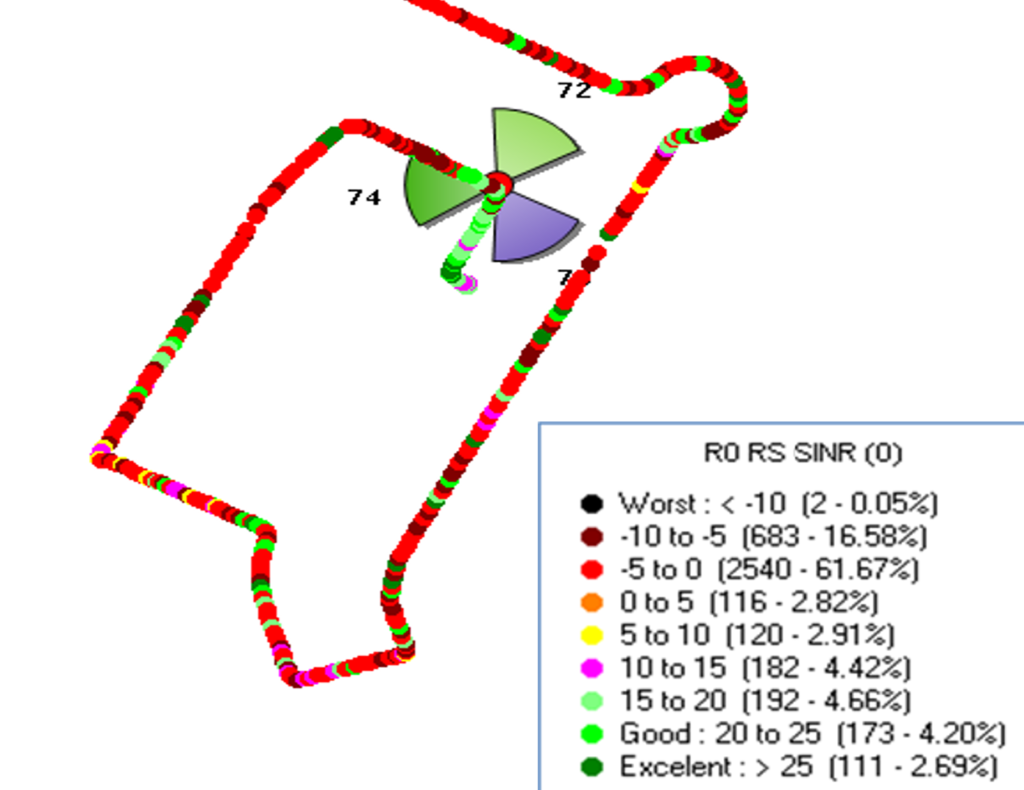In LTE (Long-Term Evolution) networks, SINR, or Signal-to-Interference-plus-Noise Ratio, is an important measurement metric used to evaluate the quality of wireless connections. SINR provides insight into the level of interference and noise affecting the signal, which directly impacts the overall performance and reliability of the LTE network.
Below picture shows SINR PLOT & Threshold values in LTE network during drive test field.

SINR Definition and Calculation.
SINR is a measure of the quality of the received signal relative to the level of interference and noise. It is calculated using the following formula:
SINR = S / I + N
- S (Average Received Signal Power): The power of the desired signal.
- I (Average Interference Power): The power of interfering signals from other sources.
- N (Noise Power): The power of background noise.
This ratio helps quantify how much the signal is affected by interference and noise, providing a clear indicator of connection quality.
Importance of SINR.
SINR is a key indicator of the quality of LTE wireless connections. Its significance includes:
- Quality Measurement: SINR is used to assess the quality of the received signal, accounting for both interference and noise. Higher SINR values indicate better signal quality and more reliable connections.
- Impact of Path Loss: As the distance from the cell site increases, the signal strength (S) decreases due to path loss, which is influenced by environmental factors such as buildings, terrain, and other obstacles.
- Network Performance: A high SINR value is essential for achieving high data rates and maintaining stable connections. Poor SINR can lead to increased error rates, lower throughput, and degraded user experience.
- Adaptive Modulation and Coding (AMC): SINR is used in algorithms for adaptive modulation and coding, helping the network to dynamically adjust modulation schemes and coding rates to match the current radio conditions.
Radio Conditions for SINR Measurement.
SINR measurements are influenced by various radio conditions, including:
- Environmental Factors: Background noise levels, physical obstructions, and weather conditions can all impact SINR.
- Interference Levels: Interference from other cell sites, co-channel interference, and interference from non-cellular sources can degrade SINR.
- Distance from the Cell Site: SINR typically decreases as the UE moves farther from the cell site due to increased path loss and higher susceptibility to interference.
- Network Load: Higher network traffic can increase interference levels, negatively affecting SINR.
SINR Ranges.
SINR values can vary widely, typically ranging from negative values (indicating very poor signal quality) to positive values (indicating good signal quality).

Here is a general classification:
- High SINR (>20 dB): Excellent signal quality with minimal interference.
- Moderate SINR (10 to 20 dB): Good signal quality, suitable for most applications.
- Low SINR (0 to 10 dB): Poor signal quality, might experience degraded performance.
- Negative SINR (<0 dB): Very poor signal quality, likely to experience significant performance issues.
Conclusion.
SINR is a fundamental metric in LTE networks, providing a comprehensive measure of signal quality by accounting for both interference and noise. High SINR values are essential for achieving optimal network performance and ensuring a high-quality user experience. By continuously monitoring and optimizing SINR, network operators can enhance the reliability, efficiency, and overall performance of LTE networks, delivering better services to users.